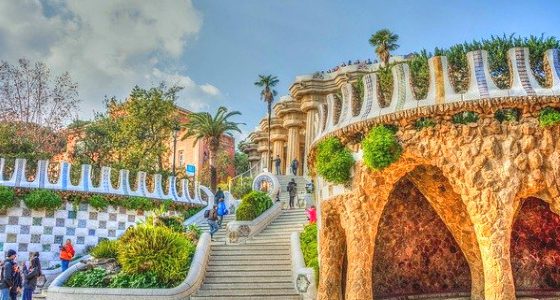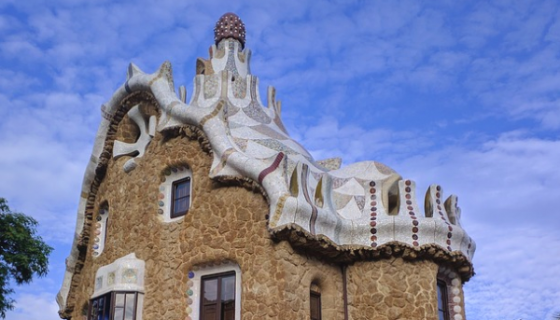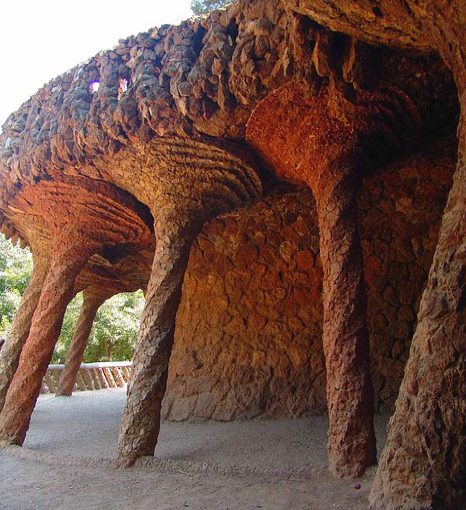After the church Sagrada Familia, the park Güell is the second biggest sight of Barcelona. About 3 million people, mainly tourists from abroad, visit the Park Güell every year (Catalan: Parc Güell, Spanish: Parque Güell).
Beware limited access Park Güell: >>> You have to buy the tickets online in advance (click here)

The park is named after the millionaire Eusebi Güell (1846 to 1918), who had the complex built. The architect was Antoni Gaudi, probably the most famous Catalan of all times. He created the park with the unusual buildings between 1900 and 1914. The style is unique, typical Gaudi. There is a large square, the La Placa. Famous are also the two houses at the entrance with zigzag cast roofs. The high pedestrian bridges are also much admired in the photographs.
Our tip Barcelona local transport tickets: Tickets (day tickets) for the very well-developed local transport system in Barcelona can be bought in advance on this website. Then you don’t have to deal with the Spanish machines or with employees who don’t understand English.

Admission to Park Güell 2025
Important: The park has access restrictions. Only 400 visitors per half hour are allowed in. If you get to the world-famous park of Gaudi without a ticket, you often have to wait for hours. Waiting in line at the ticket office can also take a long time. Every visitor gets a detailed explanation at the cash desk. One often waits for hours in line. Even on a weekday in November we waited an hour and then got a ticket for half an hour later. So make sure you buy your ticket with date and time online! >>> You have to buy the tickets online in advance (click here)
The entrance fee to Park Güell is 10 Euro for adults. This is almost cheap for such a famous sight, in the church Sagrada Familia you pay 30 Euro locally.
The following tickets are available for Park Güell for 2025:
Adults and children over 12 years (21 Euro): buy ticket
Children from 7 to 12 years and older visitors from 65 years (16 Euro): buy ticket
Children under 7 years and disabled free of charge, you still need a ticket: buy ticket
Guided tours: There are also guided tours through the Parc Güell for about 39 Euro with admission. These should also be bought in advance. On this link there are tickets with guided tour

Opening hours Park Güell 2025
In summer daily from 8 am to 9:30 pm. In other seasons Parque Güell has shorter opening hours, but at least from 8:30 a.m. to 6:15 p.m. Last admission is usually 45 minutes before closing time. There are no closed days, even on Christmas Eve, New Year’s Eve etc. you can visit Gaudi’s masterpiece Park Güell.
Beware limited access Park Güell: >>> You have to buy the tickets online in advance (click here)
Approach Park Güell
It’s not an easy subject. There is no metro station directly near one of the entrances. You walk uphill for about 20 minutes. Park Güell is on a hill above the city.
The best underground station to Park Güell is Vallcarca (line 3, green line). From here escalators were built on the street for the many visitors of Park Güell. Only a few smaller parts of the ascent still have to be walked. Unfortunately most of the escalators did not work during our visit in November 2019. Thus the way to the top was very exhausting again.
After the visit of the park Güell we walked downhill towards the city centre to the church Sagrada Familia. About 25 minutes on foot.
Beware limited access Park Güell: >>> You have to buy the tickets online in advance (click here)
Our tip Barcelona local transport tickets: Tickets (day tickets) for the very well-developed local transport system in Barcelona can be bought in advance on this website. Then you don’t have to deal with the Spanish machines or with employees who don’t understand English.
Park Guell: More information for visitors
Park Guell Barcelona is a famous park in Barcelona, Catalonia, Spain. One of the city’s most popular tourist attractions, it attracts millions of visitors every year. The park was designed by the famous Spanish architect Antoni Gaudi and built between 1900 and 1914. Originally planned as a residential area for wealthy families, it was later transformed into a park. The park was declared a UNESCO World Heritage Site in 1984. Visitors to Park Güell will discover a unique blend of natural beauty and architectural splendour. Situated on a hill overlooking the city, the park offers spectacular views of Barcelona and the Mediterranean Sea. The park covers an area of 17.18 hectares and is divided into two main zones.
Monumental Zone and Free Access Zone.
The Monumental Zone is a paid entrance area to the park and contains some of the most emblematic features of Park Güell. Here you will find the famous dragon staircase that leads to the Hypostyle Hall, a large room supported by 86 Doric columns. The space was originally intended to serve as a marketplace for the housing estates, but was then transformed into a public space. The Hypostyle Hall features a colourful ceiling covered with mosaics made from broken roof tiles.
Another famous feature of the monumental area is the natural square in the middle of the park. Surrounded by long benches covered with colourful mosaics, the square offers a panoramic view of the city. It is said that the bench is the longest in the world and features intricate patterns and motifs made from ceramic pieces. Open access areas are areas of the park that are freely accessible and include many of the park’s natural features. Here visitors can explore the various paths and trails that wind through the park and admire the different types of plants and trees. Also in the freely accessible area is the Gaudi House Museum, the former home of Antoni Gaudi and now a collection of his works.
When visiting Park Güell Barcelona, it is important to plan ahead and arrive early in the day to avoid long queues and crowds. The park is open around the clock and entry to the monumental area is only possible with a timed ticket. Visitors can buy tickets in advance online or at the park entrance, but tickets often sell out quickly in high season.
In addition to the park’s main attractions, there are also many details and hidden treasures to discover throughout the park. Visitors can take their time exploring the park and discover the many sculptures, mosaics and carvings found throughout the park. Other artistic features should be noted.
Our tip Barcelona local transport tickets: Tickets (day tickets) for the very well-developed local transport system in Barcelona can be bought in advance on this website. Then you don’t have to deal with the Spanish machines or with employees who don’t understand English.
Overall, Park Guell is for every visitor to Barcelona. The unique blend of natural beauty and architectural splendour makes it a truly unforgettable experience. Whether you like art, architecture or simply spending time in nature, Park Guell has something for everyone.
The following tickets are available for Park Güell for 2025:
Adults and children over 12 years (21 Euro): buy ticket
Children from 7 to 12 years and older visitors from 65 years (16 Euro): buy ticket
Children under 7 years and disabled free of charge, you still need a ticket: buy ticket
Guided tours: There are also guided tours through the Parc Güell for about 39 Euro with admission. These should also be bought in advance. On this link there are tickets with guided tour
Our pages about Barcelona & surroundings
| Information about places and sights | link |
|---|---|
| Barcelona – capital of Catalonia with culture, beaches and architecture | Click here |
| Sagrada Família – Gaudí’s unfinished masterpiece and landmark | Click here |
| Park Güell – Colorful park with views and mosaics by Gaudí | Click here |
| Aquarium Barcelona – Sea creatures in impressive glass tunnels | Click here |
| Tour Camp Nou Stadium – A look behind the scenes at FC Barcelona | Click here |
| Lloret de Mar – Popular seaside resort with nightlife on the Costa Brava | Click here |
| Figueres – home of the famous Dalí Museum in northern Catalonia | Click here |
Park Güell: Top 20 attractions
Here are the top 20 attractions and features of Park Guell Barcelona:
Dragon Stairs – A colourful dragon statue that guards the entrance to the park.
Hypostyle Hall – A large room supported by 86 Doric columns, with a colourful ceiling covered in a mosaic of broken tiles.
Natural Square – A large square surrounded by long benches covered in colourful mosaics, offering panoramic views of the city.
Gaudi House Museum – Former home of Antoni Gaudi and now houses a collection of his works.
Monumental Zone – A chargeable area of the park that includes some of the most emblematic features of Park Guell.
Free Access Zone – An area of a park that is free to access and contains many of the park’s natural features.
The Terrace – Large terrace with breathtaking views of the city and the Mediterranean Sea.
Viaduct – A series of arches that support the upper levels of the park and create excellent photo opportunities.
Toilet Portico – A covered area originally intended as a toilet in a housing estate.
Piazza Natura – Large open space in a freely accessible area with magnificent views of the city.
Austrian Gardens – A small garden at the top of the park offering a quiet retreat from the hustle and bustle.
Three Crosses – Three large crosses at the top of the hill offer magnificent views of the city and the sea.
Caves – Cave-like structures with waterfalls and colourful mosaics.
Market Place – A large open area originally intended as a market place for a complex of buildings.
Terrace of Columns – A covered terrace with a series of columns covered with colourful mosaics.
Hypostyle Hall Staircase – A series of stairs leading to the Hypostyle Hall decorated with colourful mosaics.
Palmela Square – Large square in the open access area with palm trees and magnificent views of the city.
Serpentine Bench – Long bench with colourful mosaics, considered the longest bench in the world.
Washerwoman’s Portico – A covered area originally intended to serve as a laundry room in a residential development.
Entrance to the Monumental Area – Entrance to the Monumental Area with large arches covered in colourful mosaics.
Beware limited access Park Güell: >>> You have to buy the tickets online in advance (click here)
Park Güell Insider Tips – More than just colorful mosaics
Park Güell is one of Barcelona’s most famous highlights – colorful, playful, and a masterpiece by Antoni Gaudí. Sure, many tourists come for the colorful lizard, the wave-shaped bench, and the fantastic view. But here are a few tips for an even better and more relaxing experience.
1. Arrive early or leave late
The park opens early, usually at 8 a.m. Those who arrive early enjoy the peace and quiet, have more space for photos, and experience the morning light on the mosaics. Alternatively, it’s also worth visiting shortly before closing—many tourists will have already left.
2. The Free Part of the Park
Not everyone knows that only part of the park has an admission charge. The larger free area is ideal for strolls and hidden corners away from the crowds. There, you can enjoy nature and even discover small caves and paths.
3. Unknown Viewpoints
In addition to the famous main square, there are several less frequented viewpoints, for example, around the monumental staircase or along the hidden paths at the back of the park. Here, you’ll find peace and a great view of Barcelona without the stress of taking selfies.
4. Photo Spots Without Tourists
The large, wave-shaped bench is very well-known—but often completely overcrowded. Tip: Go a little further into the park, perhaps to the “Viaduct” or the hidden pavilions with their colorful roofs. There, you’ll be able to take unique photos with fewer people.
5. Picnic instead of a café
There are no restaurants in the park, but there are plenty of lovely spots to relax. Pack a snack and a water bottle – preferably early or late – and enjoy your picnic with a view of the city.
6. Guided tour or audio guide
If you want to learn more about Gaudí’s ideas and history, an audio guide or a short guided tour is worthwhile. This way, you’ll discover details that many overlook – such as hidden symbolism or architectural tricks.
7. Park Güell in the evening
In the evening, the park is less crowded and the temperatures more pleasant. You can also enjoy great views of the city lights from the park. However, entry to the monumental areas is often no longer possible at this time, so use the free area!
8. Combine travel and tickets cleverly
Book your tickets online in advance to avoid long lines. Many people combine their visit with a visit to the nearby Sagrada Família or a stroll through the Gràcia district, which is just around the corner and offers great cafés and boutiques.
Park Güell Barcelona – all important articles
| Overview & basics: | |
Park Güell Barcelona |
Facts about Park Güell |
| History, architecture & Gaudí: | |
Park Güell – history |
Gaudí Park Güell |
| Sights & photo spots: | |
Sights Park Güell |
Photo spots Park Güell |
| Visit planning & timing: | |
Best time Park Güell |
How long does a visit take? |
Opening and closing times of Park Güell |
Is photography allowed in Park Güell? |
| Monumental zone & free areas: | |
| Monumental zone vs. free areas explained | Visit Park Güell for free? |
| With children & insider tips: | |
Park Güell with children |
Insider tips for Park Güell |
| Rules & pets: | |
Are dogs allowed in Park Güell? |
|
| Getting there: | |
Getting to Park Güell |